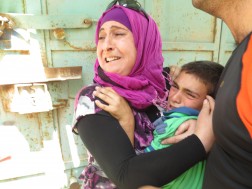Category: Reports
-
Night raids and arrests in Hares, Kifl Hares and Deir Istiya
1st May 2013 | International Women’s Peace Service, Salfit, Occupied Palestine Yesterday night, at 21:40, an announcement was made over the mosque loudspeaker in Deir Istiya that settlers were planning an attack. Villagers were warned to stay wake and on watch for possible violence. At 22:45 IWPS began a night watch in Deir Istiya and…
-
12- and 11-year old Palestinian children arrested after attack by settler children – Swedish activist also arrested, resisting deportation
28th April 2013 | International Solidarity Movement, Hebron, Occupied Palestine By Team Khalil UPDATE 2nd May 09.30 Full video of child arrests now available from Youth Against Settlements. Swedish activist Gustav is resisting deportation to highlight the issue of child arrests in Hebron which have seriously escalated in recent months. UPDATE 29th April 20.00 Gustav,…
-
Villages of Urif, Burin and Asira violently attacked by settlers
1st May 2013 | International Solidarity Movement, Nablus, Occupied Palestine By Team Nablus Yesterday Israeli settlers from the Illegal settlement of Yizhar set fire to the fields of Asira al Qibliya, Burin and Urif as well as attacking the school and many homes in the villages, all while the Israeli Military and Border Police provided…

